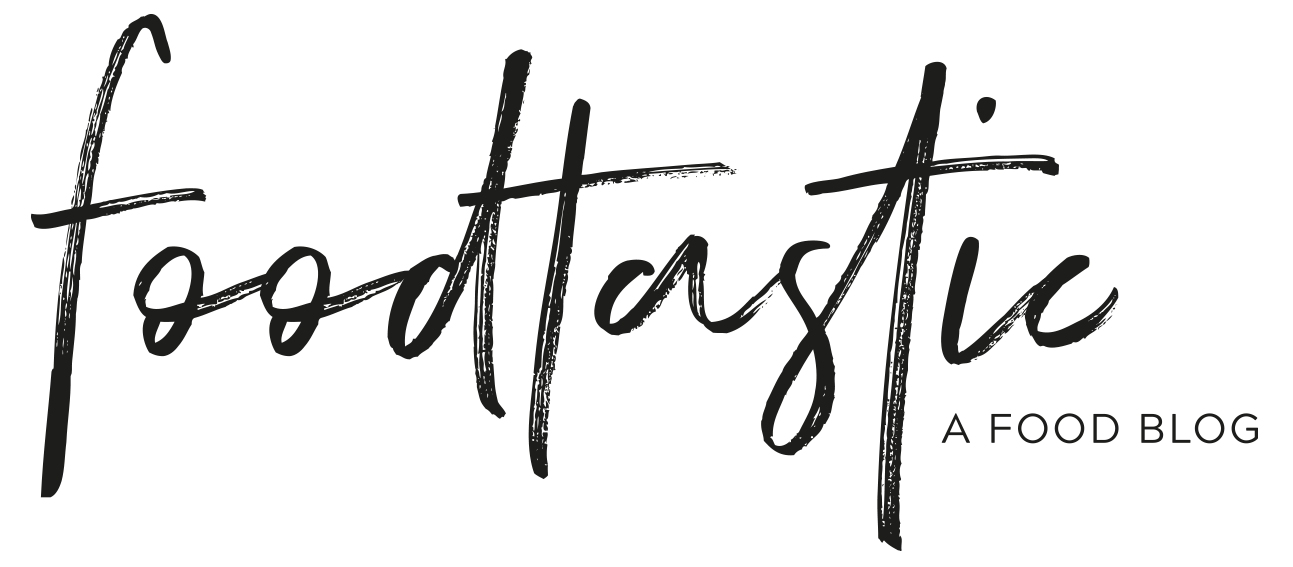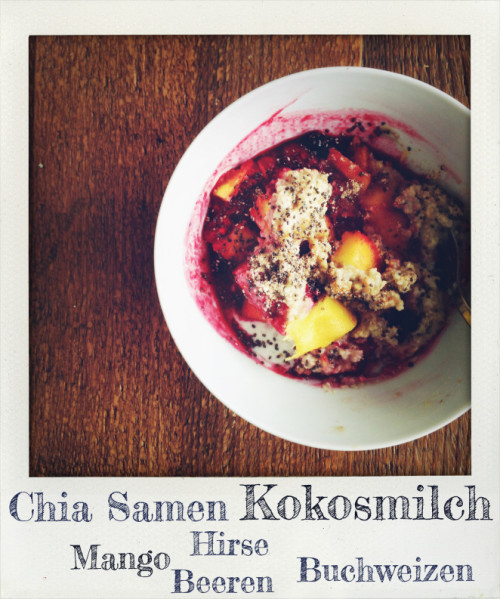From Quinoa to Millet to Polenta Porridge
There is a huge range of muesli and porridge recipes and myriad ways of preparing them. For the most part, our standard morning mueslis are quite plain: oatmeal or crunchy granola with milk and/or yoghurt, topped with berries. I like my porridge warm and extravagant, so every morning, I make my own individual, warm porridge variation. Here are four absolutely delicious, gluten-free and healthy porridge dishes featuring alternative grains. Definitely a health and energy boost to start the day!
Number 1 - The Early Morning has Gold in its Mouth
I eat MorgenStund's millet and buckwheat porridge almost daily - with slight variations. I've posted about this before, when my blog was just 3 days old. The Morgenstund-mixture is gluten and lactose free and doesn't have added sugar. Alongside millet and buckwheat, it also contains amaranth, sunflower seeds, pumpkin seeds and almonds. Bits of apple and pineapple add sweetness.
The preparation is really easy - it takes all of 5 minutes and you have a delicious porridge dish in front of you. The package label tells you to prepare the mixture with water. I occasionally like to use millet milk or normal milk or even a half water/half milk concoction.
Ingredients:
3 TBSP MorgenStund millet-buckwheat porridge
60ml water
60ml milk (or instead, use a total of 120ml water)
mixed berries
2 TBSP pumpkin seeds*
1 TBSP brown millet**
3 TBSP plain yoghurt
freshly squeezed juice of 1/2 orange
1-2 tsp honey
Preparation:
1.) Bring water and/or milk to the boil and stir in the MorgenStund mixture with a whisk. Boil while continuously stirring and let simmer over a low heat for around 1-2 minutes.
2.) Serve the cooked millet porridge in a bowl, stir in the orange juice, yoghurt and honey and top with the fresh (or defrosted) berries or other fruit, brown millet and pumpkin seeds.
*Pumpkin seeds:
Pumpkin seeds contain a ton of essential ingredients and vitamins and have an extremely beneficial effect on our health. They offer lots of unsaturated fatty acids that our body needs. They also contain vitamin E, known for its antioxidant properties, as well as beta-carotene, magnesium, iron, zinc and selenium. Pumpkin seeds are said to relieve bladder and prostate problems. Eat 2-3 tablespoons of pumpkin seeds daily for best results!
**Brown millet:
I buy this at the organic food store in the shape of a finely ground flour. Brown millet contains heaps of silicea, an essential mineral. Silicea is known for improving hair and nail growth and for having a positive effect on our connective tissue. Together with calcium, it helps keep bones and joints healthy, represents essential building material for cartilage and contains an anti-inflammatory trace element. Brown millet is particularly beneficial for people suffering from osteoporosis.
Number 2 - Millet Porridge with Coconut Milk, Mango and Chia Seeds
For this variation, I also used the MorgenStund ® millet and buckwheat mixture, but cooked it in coconut milk and served it with more exotic ingredients.
Ingredients:
3 TBSP MorgenStund millet-buckwheat porridge
60ml water
80ml coconut milk
1 TBSP coconut milk extra
¼ mango
4 TBSP fresh or frozen berries
2 TBSP chia seeds (learn here why Chia-Samen are so healthy)
2 TBSP brown millet
Preparation:
1.) Prepare MorgenStund-mix as above. This time, use 60ml of water and 80ml of coconut milk.
2.) Peel the mango and chop into small pieces. Thaw the berries and cook them, if you like. Combine the Morgenstund with berries, mango and a tablespoon of coconut milk. Garnish with chia seeds and brown millet.
*How to peel a mango:
The easiest way to peel and process a mango is to use a ripe one (let it sit at home for a few days if it's still too young). Cut lengthwise along the pit with a sharp knife. Use a spoon to remove the pit by scraping as close to it as possible. Now cut a checkerboard pattern into the mango pulp on the inside while taking care not to damage the outer skin. Take mango halves into your hands and push the skin inwards so the pulp ends up on top. Now you can pick the pieces off easily.
Number 3 - Quinoa Porridge with Rhubarb Compote, Coconut Milk and Chopped Almonds
I use quinoa quite a lot in my cooking, but mostly in salads or as a side dish. Until I went to Australia last autumn, I had never had it for breakfast. Since then, I think it's a great idea.
Quinoa is one of humanity's oldest crops. It has been a staple food for the indigenous tribes of the South American Andes for 6000 years. Quinoa is a so-called pseudo-cereal and is a species of the goosefoot genus. Botanically, it is related to spinach, chard and beetroot. Quinoa contains several essential substances and is a better source of protein than other common grains through its unique molecular structure. It is high in calcium, magnesium, iron and zinc and also contains several B-vitamins and a ton of vitamin E. It consists only of beneficial unsaturated fatty acids, making it somewhat of a superfood.
When you prepare quinoa, you should rinse the seeds well under hot, running water to get rid of the bitter-tasting saponins that could still be present in the hulls.
And now the recipe for the amazing quinoa porridge...
Ingredients:
90g quinoa
100ml water
200ml coconut milk*
2-3 TBSP almonds**
2-3 TBSP hazelnuts
1 banana
Ingredients for a quick rhubarb compote:
3 sticks rhubarb
3-5 TBSP sugar
25g butter
1 TBSP apple cider vinegar
Preparation:
1.) Bring lightly salted water and the coconut milk to a boil. Rinse quinoa in a sieve under running water until it runs clear. Then add quinoa to the water-coconut milk mixture, bring to the boil and cook for around 20 minutes.
2.) In the meantime, prepare the compote. Clean, top and tail the rhubarb and chop into pieces. If the sticks are too fibry, peel them.
3.) Put sugar, butter and apple cider vinegar in a pot, bring to the boil and cook for 5 minutes. Add the rhubarb and let simmer over a low heat for around 5-6 minutes. Set aside and keep warm.
4.) Chop the almonds and hazelnuts. Finely chop the banana and mix under the quinoa porridge. Serve in a bowl, pour rhubarb compote on top and garnish with chopped nuts.
I ate this at a coffee shop in Australia, which offered a cold espresso shot with their porridge. I tried it and it was amazing! A different way to get started in the morning. No worries!
*Coconut milk:
Coconut milk, as opposed to coconut water, doesn't occur in the actual coconut. It is made by pureeing the pulp and squeezing the mixture through a cheesecloth. This produces a milky, aromatic liquid with a fat content of between 15 and 25%. Coconut milk is very rich and doesn't just enhance Asian dishes like curries but also desserts and breakfast cereals. It is made up of medium-chain fatty acids making it the ideal food to provide a quick energy boost. Also, the fat of the coconut milk doesn't deposit itself onto the fatty tissue of your body.
** Almonds:
Almonds have high nutritious value: they contain carbohydrates, proteins and almond oil, are rich in vitamins B1, B2 and E, fatty acids and minerals like calcium, potassium and magnesium. They also are chock-full of antioxidants and are known to lower cholesterol as well as reducing the risk of arteriosclerosis and cardiovascular diseases.
Number 4 - Sweet Polenta Porridge with Rhubarb Compote & Chopped Pumpkin Seeds
I once enjoyed this yummy porridge variation at Vienna's 7th district gem Espresso. As a coeliac sufferer, I love discovering gluten-free alternative muesli and breakfast dishes like this polenta porridge version.
Ingredients:
60g 1-minute-polenta*
250ml milk
1 pinch of salt
1 TBSP butter
Rhubarb compote (ingredients and preparation see above)
4 TBSP pumpkin seeds
Preparation:
1.) Add the lightly salted milk to a pan and bring to the boil. Then, pour in the polenta in a slow, steady stream while stirring all the time (careful: this produces bubbles that might splash). Only cook the polenta for 1-2 minutes and set aside. If it's too thick, add a little bit of water. Mix in some butter at the end.
2.) Chop the pumpkin seeds. Serve the polenta porridge in a bowl, pour the rhubarb compote over it and garnish with the chopped pumpkin seeds.
*Polenta:
Polenta is a dish made from cornmeal. It can be enhanced with milk and/or parmesan. Polenta counts among the oldest dishes made from grain and was used as an energy boost as far back as Roman times. It comes finely, medium finely and coarsely ground. You can often buy pre-cooked or quick-cook polenta, which reduces preparation time considerably. Polenta is rich in potassium, magnesium and iron and also contains silica, which strengthens hair and nails.
By the way, you can mix your own muesli at Verival now, including gluten-free oats. I tried it and loved it!







